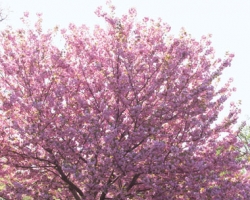Since I had a number of items that I could use for subject matter I thought it might be wise to pen another one of those olio-type columns.
In the past few days I seem to have gotten around more out of the valley, even venturing north of Interstate 8, something I seldom do. In our travels we note that those beauties of Southern California foliage, the jacaranda, are out in all their bluish-purple splendor.
The land in which we live has bestowed on us many trees, shrubs and other growth that are of lustrous and difficult to describe hues. They are seasonal, of course, and that is as it should be.
Nature begins her colorful show sometime in late winter or early spring. We see the yellow acacia, the flowering peach and the wild mustard dressing up the empty lots and the back country fields.
If we had a good supply of rain in the just past winter the home-grown bougainvillea of various shades and hues brighten up gardens and yards adding to the splendor of the plants growing wild. But to our way of thinking, all that foliage in all its splendor would find it hard to compete with the jacaranda.
Jacaranda, for various reasons, generally reminds me of the late John Rojas. Rojas, you might remember, was a local historian and writer. He, in fact, founded the Chula Vista Historical Society and it was he who was most responsible for the tales and anecdotes that have been told regarding the early history of the South Bay area.
Back in 1996 Rojas wrote and published a book titled “Chula Vista Trees – Immigrants that Came to Stay.”
Rojas is, of course, alluding to the fact that most of the trees, and some shrubbery, are native to some other land, and they have been brought to our soil where they are going to flourish.
The cover of “Chula Vista Trees” is the jacaranda, full name Jacaranda mimosifolia. Rojas tells us that the jacaranda – at least the ones that grow here – are natives of Brazil.
They, however, grow in many other places, Australia and South Africa to name two. The literature tells us that the community of Pretoria, South Africa, is noted for its jacaranda. They have been planted and grow profusely on the grounds of their local university.
Since they bloom in the late spring, the time when finals are given at the university, folklore says that if one of the blue blooms falls on your head you will ace your finals.
We mention this bit of lore because we know that Southwestern College is rich with jacarnda. As one enters the campus from Otay Lakes Road the jacaranda is the first thing you see. I wonder if any student knows about the Pretoria belief. If so, at finals time, take a stroll under the jacarandas. It’s only folklore, but what the heck, when taking finals every little bit helps.
¥ ¥ ¥
There are those of us – particularly those who lead humdrum lives – who often take pleasure in the accomplishments of others, that is, our siblings, our kids or simply some distant kin.
Ray Baldisseri is a kin of mine of sorts. Some 60 years ago he married my younger sister Marie and they have made their home in the Miami area.
Ray, you see, is a professional singer, a baritone who has entertained scores of people in various clubs and other venues in south Florida.
In 1956 he recorded and sang a song titled “Abilene.” It is about the Abilene in Kansas, not Texas, and it was to aid Dwight Eisenhower on his quest to be reelected to the presidency. We fast forward to the present and find that the song, the recording done by Ray, and other things pertaining to the song are going to be enshrined in the Eisenhower Museum in Abilene, Texas. And Ray and sister Marie are principals at this unveiling. Kudos to brother-in-law Ray. And also to me for being related.











